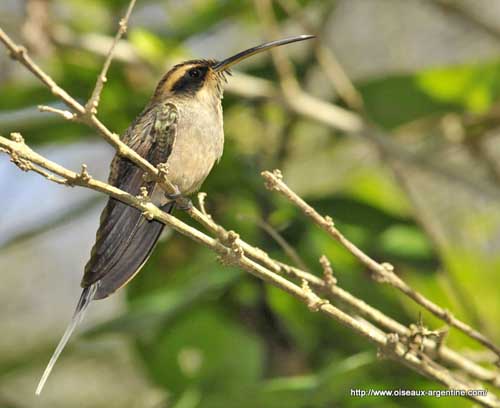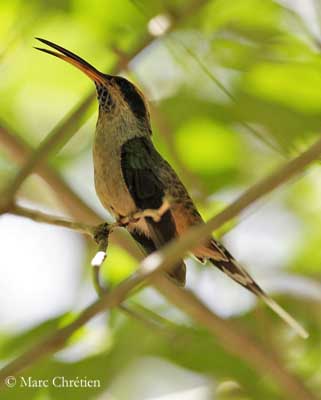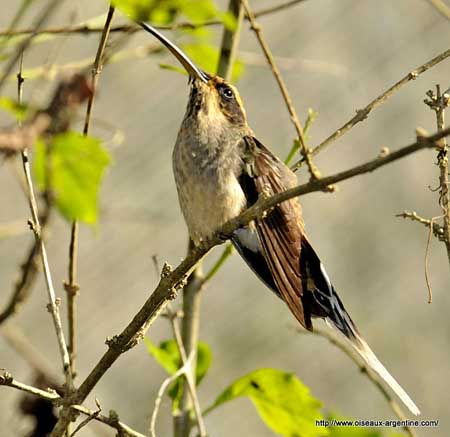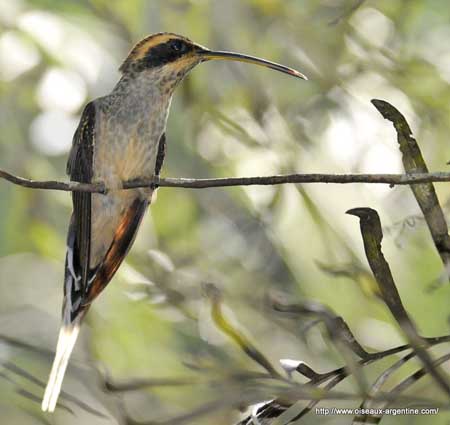
Fr: Ermite eurynome
All : Schuppenkehleremit
Esp: Ermitaño de Pico Negro
Ital : Colibrì del sole becconero
Nd : Schubkeel-heremietkolibrie
Sd : Fjällstrupseremit
Port : Rabo-branco-de-garganta-rajada
Photographers:
Marc Chrétien
MURINUS
Philippe et Aline Wolfer
OISEAUX D'ARGENTINE
Text by Nicole Bouglouan
Sources:
HANDBOOK OF THE BIRDS OF THE WORLD Vol 5 by Josep del Hoyo-Andrew Elliott-Jordi Sargatal - Lynx Edicions - ISBN: 8487334253
Avibase (Lepage Denis)
http://www.bsc-eoc.org/avibase/avibase.jsp
BirdLife International (BirdLife International)
http://www.birdlife.org/worldwide/index.html
Wikipedia, the free encyclopaedia
http://en.wikipedia.org/wiki/Main_Page
XENO-CANTO – Sharing Birds sounds from around the world
http://www.xeno-canto.org/
Scale-throated Hermit
Phaethornis eurynome
Apodiforme Order – Trochilidae Family
BIOMETRICS:
Length: 14 cm
Weight: M: 4,5-6 g – F: 4-5 g
DESCRIPTION:
The Scale-throated Hermit is common in the understorey of the Atlantic Rain Forest and other types of woodlands. This is a South American species.
This medium-sized hermit has brownish-olive upperparts with pale buff-edged feathers, giving scaled effect. There is a greenish iridescence on shoulders, back and tail base according to the lighting.
On the wings, the flight feathers are dark brown to blackish. The tail is graduated, with broad white margins on dark brown rectrices.
The underparts are buffy-grey. The throat is dark with narrow pale buff edges to feathers, forming scaling appearance.
On the head, forehead, crown and nape are pale brown with black-edged feathers. We can see a black mask from lores, through the eyes, extending to the head sides. Eyebrow and malar stripe are pale cinnamon.
The long down-curved bill has black upper mandible and yellow lower mandible. The eyes are dark brown. Legs and feet are grey-brown.
The female has similar plumage, shorter wings and her bill is slightly more down-curved.
The second race P.e. paraguayensis is similar but smaller in size.

VOICE: SOUNDS BY XENO-CANTO
The Scale-throated Hermit, as other members of genus Phaethornis, is very vocal from early morning to dusk, all year round, except during the peak of dry season when the sources of nectar are reduced, and during the moulting period.
They are persistent tireless daytime singers.
HABITAT:
The Scale-throated Hermit frequents the Atlantic Rain Forest, humid areas in semi-deciduous forest, moist forest, understorey of lowland and montane forest, and old second growth.
It may be common in mountainous areas according to the range, and can be seen between 100 and 2200 metres of elevation.
RANGE:
The Scale-throated Hermit occurs in NE Argentina, SE Brazil and E Paraguay.

BEHAVIOUR:
The Scale-throated Hermit feeds primarily on nectar from numerous plant species, and also consumes small arthropods.
The long, slightly down-curved bill provides access to long-tubed flowers, very rich in nectar. They feed by “trap-lining”, visiting a circuit of specific plant species, or feeding sites.
The small arthropods are collected by hover-gleaning from plants or spiders’ webs.
It is often seen alone, but the pair may be aggressive when defending the feeding area.
This species is probably sedentary in its range.
FLIGHT:
The Scale-throated Hermit, as all the Trochilidae species, performs hovering in front of the visited flowers.

REPRODUCTION:
The breeding season occurs between September and March in Brazil.
The nest structure is adapted to the wet lowland forests where this bird is living. The water coming from the heavy rains passes through the bottom of the cone-shaped nest.
It is made with plant materials and cobwebs, and attached to the inner tip of a palm leaf, fern or Heliconia (hermits are often associated to Heliconia). This is a compact pendent nest made with vegetal fibres bound with spiders’ webs. It is decorated with Spiloma. This lichen often releases red pigment on female’s belly, involving a pink coloration on the eggs.
The female lays two eggs, and incubates during 17 days. The young fledge about three weeks after hatching.

DIET:
The Scale-throated Hermit feeds on nectar from numerous plant’ species, and also consumes small arthropods.

PROTECTION / THREATS / STATUS:
The Scale-throated Hermit is common and relatively widespread in its range.
This species is not currently threatened.
